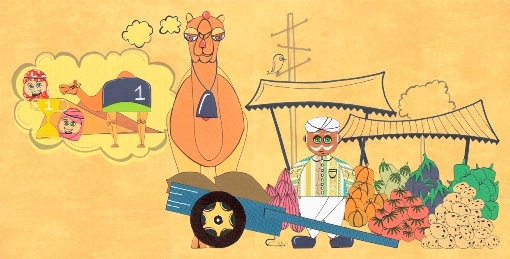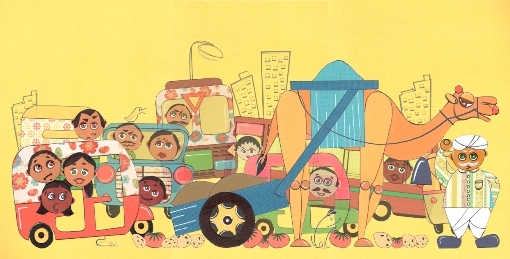Lively children’s book Bye,
Bye, Motabhai! by Kala Sambasivan follows the tortuous trail of a camel,
Pavan Putra Ram Kishen Oont, while he escapes his demoralizing vegetable-cart
job with the help of four adventurous children. At each turn, goofy and crafty
Pavan (named “wind” for his speed) leaves chaos in his wake, and races toward
freedom in Dubai. Readers become caught up in his quest, cheering for the camel -- and rising up against the adult world’s rigidity. The book teaches not only literacy
and morals, but also offers a vista into the six million-population city
Ahmedabad, India, introducing its flavors, tapestries, and
vocabulary.
Pavan, a first-class
racing camel who thirsts for international success in Dubai, represents our
childhood aspirations trapped behind the drudgery of a vegetable cart. How can
we help but root for him? Motabhai, the vegetable cart owner, tries to keep Pavan
in his place: “You crazy camel,/ Don’t you dare!/ You’re are not going/
ANYWHERE!” Motabhai’s pea-sized ambitions serve as a kind of parable: Run away
from anyone who tries to limit your dreams. Luckily, Pavan’s talent is the very
thing that helps him escape.

The illustration by
Ambika Sambasivan (the writer’s daughter) pops off the page with textures so
three-dimensional, you might touch them and expect to feel bumps and lines. Her
collages of intricate patterns show up in unexpected places, such as a floral
car roof, a candy cane towel, and the ornate shirt of humble sabzi-wala
(vegetable seller) Motabhai. This accentuates the vivaciousness of Ahmedabad’s
streetlife, as well as the cacophony of Pavan’s journey. Other visual aspects
show thoughtful storytelling. As Pavan races through the city, Ambika outlines
background buildings in a calligraphic style, as if to show the city whizzing
by. Not until Pavan stops to rest are the buildings filled with rich color,
once the camel has the time to notice their full detail.
The diction and Indian
vocabulary sprinkled throughout the story mirror the fanciful illustration.
When Pavan detours into crowded Manek Chowk, Kala Sambasivan writes: “The
market was tightly packed with small shops selling saris, dupattas,
shawls, and sheets. Yards of cloth hanging from shop windows danced in the
breeze.” Lyrical lines such as these aid children in pronouncing new words.
They also resemble a nursery rhyme that readers enjoy repeating again and
again.

Occasionally, parallel
structure is overused and cliches creep in. For example, “Cars and vans, autos
and bicycles, trucks and buses came to a screeching halt. Drivers yelled and
honked. Dogs yelped and barked. Little children clapped and laughed.” But crisp
and unexpected words predominate, such as “hullabaloo,” “gurgled,” and
“meddlesome.” Unlike many books intended for children as young as six years
old, Bye, Bye Motabhai! entrusts kindergarteners to appreciate dense
details and challenging vocabulary.
Readers follow Pavan as
he darts from market to courtyard, charging rightward like an arrow pointing to
the next page. Pavan had picked up four children on their way to school at the
beginning of his travels, and the students gamely untangle the camel when a
clothesline ensnares his long neck. The children, like Pavan, shun their
obligations and revel in adventure. A procession of law-abiding citizens trails
them: a policeman, Motabhai, the children’s driver, and the owner of a donkey,
Bijilee, who gallops beside the rebels at the lead. The children seem to learn
more than they might have at school that day as they cleverly devise a way for
their newfound friends, Pavan and Bijilee, to abscond from Ahmedabad. They
learn that not every rule is worth following.
An entreaty to chase
your ambitions wherever they may lead, Bye, Bye Motabhai! thrills with
its whimsical collages, cultural lessons, and life advice for readers of all
ages.
Rebecca Huval blogs and grant writes at the documentary organization Independent Television Service. Her writing has appeared in Mother Jones, The Miami Herald, and McSweeney’s Internet Tendency.









Comments